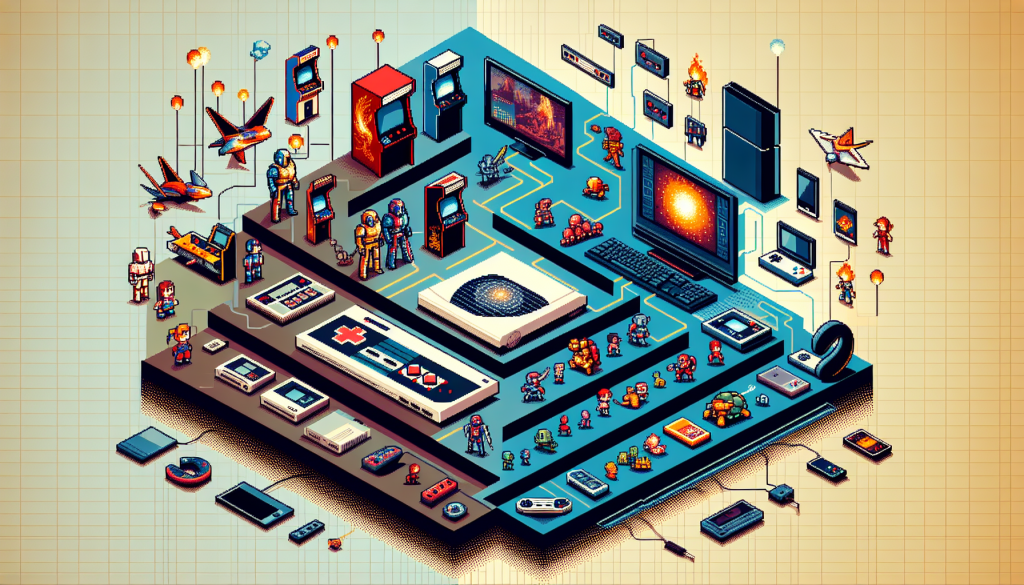Early Print Ads: Examining the Origins of Video Game Advertising
Ah, the early days of video game advertising. It’s fascinating to think about how this multi-billion dollar industry got its start. Let’s take a trip down memory lane and explore the origins of video game advertising, when print ads ruled the roost. Back in the 1970s and 1980s, video games were a relatively new and exciting form of entertainment. With the release of iconic consoles like the Atari 2600 and the Nintendo Entertainment System (NES), video games were finding their place in living rooms across the world. But how did people find out about these new games? Well, that’s where print ads came in. In those days, gaming companies would often promote their latest releases through magazines and newspapers. These print ads were eye-catching and filled with vibrant artwork that showcased the graphics and gameplay of the games. They were like windows into a whole new world of interactive entertainment. One of the most memorable early print ads was for Pac-Man, the iconic maze-chomping game that swept the nation. The ad featured the lovable yellow character, along with a catchy slogan that urged players to “Join the Pac!” It was simple, yet effective, and captured the imagination of gamers everywhere. Print ads were also a way for gaming companies to showcase their technological advancements. Take the infamous “Genesis Does What Nintendon’t” campaign by Sega. This bold ad directly compared the capabilities of the Sega Genesis console to its main competitor, the NES. It was a clever move that ignited the console wars and made gamers take notice. But print ads weren’t just about promoting the games themselves. They also played a role in building brand loyalty. Companies like Nintendo and Sega would often include newsletters or catalogs in their ads, giving gamers a sense of belonging to a larger gaming community. These catalogs showcased upcoming games, accessories, and even fan mail, creating a sense of excitement and engagement. So, what can we learn from the origins of video game advertising? Well, first and foremost, it’s important to grab the attention of your audience. In those early print ads, companies used bold visuals and catchy slogans to pique the interest of potential gamers. This is a strategy that still holds true today in the age of digital advertising. Additionally, building a community around your brand is crucial. By including newsletters or catalogs in their ads, gaming companies fostered a sense of belonging among players. This idea of community is something that can be replicated in modern advertising through social media engagement and influencer marketing. As the video game industry continued to evolve, so did the methods of advertising. The transition to television marked a new era in video game advertising, which we’ll explore in the next section. So, stay tuned!Transition to Television: Exploring the Impact of Video Game Commercials
Imagine this: you’re sitting on the couch, eagerly waiting for your favorite TV show to start. The screen goes black, and suddenly, a catchy jingle starts playing. Your attention is immediately captured as a vibrant commercial comes on, showcasing the latest video game release. This was the beginning of video game commercials infiltrating our television screens. During the 1980s, video game companies recognized the power of advertising through television. This marked a significant shift in the way these interactive forms of entertainment were marketed. As the popularity of video games grew, so did the need to reach a wider audience and generate excitement around new releases. Television commercials offered a unique opportunity to captivate potential players through visual storytelling. These commercials not only showcased gameplay footage, but they also integrated captivating narratives and catchy slogans that would stick in the minds of viewers. From the iconic “Sega does what Nintendon’t” campaign to the memorable “Play it Loud” ads for the Game Boy, these commercials became a part of pop culture and left a lasting impact on the gaming industry. One of the key benefits of television advertising was the ability to reach a broad audience. Unlike print ads, which were limited to specific publications, television commercials had the potential to reach millions of viewers across different demographics. This allowed video game companies to target not only dedicated gamers but also casual players and even those who may not have considered themselves gamers at all. The impact of video game commercials on the industry cannot be overstated. These ads played a crucial role in building brand awareness and generating excitement around new releases. They also helped shape the perception of video games as a mainstream form of entertainment, reaching audiences beyond the traditional gaming community. As technology advanced, so did the production value of video game commercials. The transition to high-definition television and the advent of computer-generated imagery (CGI) allowed for more visually stunning and immersive advertisements. Commercials became more elaborate, with intricate animations and cinematic storytelling that showcased the game’s graphics and gameplay mechanics. Video game commercials also started to incorporate influential celebrities and athletes, further expanding their reach and appeal. By featuring well-known personalities who were passionate about gaming, companies aimed to tap into their fan base and leverage their influence to promote their products. This strategy not only increased brand recognition but also helped shape gaming culture by associating video games with popular figures from other entertainment industries. Transitioning from print ads to television commercials was a game-changer for the video game industry. It allowed companies to reach a wider audience, build brand recognition, and shape the perception of video games as a mainstream form of entertainment. These commercials became an integral part of the gaming experience and left a lasting impact on popular culture.The Rise of Online Advertising: Analyzing the Shift from Traditional to Digital Platforms
With the advent of technology and the internet, the world of advertising has undergone a significant transformation. The once dominant print and television ads have taken a backseat to the rising influence of online advertising. In this article, we will delve into the shift from traditional to digital platforms in the realm of video game advertising.
Gone are the days when marketers relied solely on print ads to promote their video games. In the early days of video game advertising, companies would place ads in magazines and newspapers to reach their target audience. These ads often featured captivating visuals and enticing taglines, aiming to create buzz and generate interest.
As technology advanced, video game advertising made its way to the small screen. Television commercials became an integral part of advertising strategies, allowing game developers to showcase their latest releases to a wider audience. These commercials were carefully crafted to pique the interest of viewers, often presenting snippets of gameplay and captivating storytelling.
However, the rise of the internet brought about a seismic shift in the advertising landscape. Online advertising became increasingly popular as more and more people connected to the internet. Game developers and marketers realized the immense potential of reaching a global audience through digital platforms.
Online advertising offered several advantages over traditional methods. Firstly, it allowed for highly targeted campaigns, ensuring that ads reached the right audience at the right time. Through data analysis and user profiling, marketers could identify individuals who were likely to be interested in video games and tailor their advertisements accordingly.
Secondly, digital platforms provided interactive and immersive experiences for users. Instead of passively watching a commercial, online advertising allowed users to engage with the content. Game trailers, interactive demos, and playable ads became popular forms of video game advertising, enabling potential players to get a taste of the game before making a purchase.
Additionally, the rise of social media and online communities further amplified the reach of video game advertising. Platforms such as YouTube and Twitch allowed gamers to share their experiences and opinions, creating a vast network of influencers. Game developers started collaborating with these influencers to reach their dedicated fanbases, tapping into their credibility and influence.
Nowadays, gamification has become a prominent strategy in video game advertising. Marketers create interactive experiences, such as mini-games or challenges, which users can participate in to win prizes or unlock exclusive content. This not only creates a sense of excitement and engagement but also fosters a deeper connection between the brand and the consumer.
As the digital landscape continues to evolve, video game advertising will undoubtedly adapt and innovate. Augmented reality (AR) and virtual reality (VR) are already making their mark, providing new opportunities for immersive advertising experiences. It’s safe to say that the future of video game advertising lies in the realm of technological advancements and creative storytelling.
In conclusion, the shift from traditional to digital platforms in video game advertising has revolutionized the way games are marketed. Online advertising offers targeted campaigns, interactive experiences, and the ability to harness the power of influencers. With the ever-changing digital landscape, video game advertising will continue to evolve, captivating audiences and driving the success of the gaming industry.
Gamification and Influencer Marketing: Understanding the Modern Era of Video Game Advertising
Welcome to the exciting world of video game advertising in the modern era! Gone are the days of simple print ads and TV commercials. Now, companies are leveraging the power of gamification and influencer marketing to reach their target audience in innovative and engaging ways. In this article, we will explore how these new strategies are shaping the landscape of video game advertising.
Gamification: Turning Advertising into an Interactive Experience
One of the most prominent trends in video game advertising is the use of gamification. Instead of bombarding consumers with traditional ads, companies are creating interactive experiences that allow users to engage with their brand on a deeper level. These experiences can take the form of mini-games, challenges, or puzzles that users can play while being exposed to the brand’s message.
Gamification not only captures the attention of the audience but also encourages them to spend more time with the brand. By incorporating elements of fun and competition, companies can create a memorable experience that leaves a lasting impression. This approach not only increases brand awareness but also fosters a sense of loyalty among consumers.
Influencer Marketing: Leveraging the Power of Social Media
In recent years, influencer marketing has become a dominant force in the world of advertising, and video game advertising is no exception. Companies are partnering with popular gamers, streamers, and content creators to promote their products and reach a wider audience. These influencers have built loyal followings who trust their opinions and recommendations, making them valuable assets for advertisers.
Influencers have the ability to showcase a game’s features, provide honest reviews, and create engaging content that resonates with their followers. By partnering with influencers, companies can tap into their established communities and benefit from the trust and credibility they have already built. This approach not only increases brand visibility but also fosters a sense of authenticity and relatability that traditional advertising may lack.
Blending Gamification and Influencer Marketing
Some of the most successful video game advertising campaigns combine both gamification and influencer marketing strategies. By creating interactive experiences that influencers can showcase to their audience, companies can maximize their reach and engagement. This approach allows for a seamless integration of brand messaging and gameplay, resulting in a more immersive and compelling experience for the consumer.
When done right, gamification and influencer marketing can create a win-win situation for both the brands and the gamers. Brands can effectively promote their products while gamers get to enjoy unique content and experiences. However, it’s important for companies to choose the right influencers who align with their brand values and target audience. Authenticity and genuine enthusiasm are key to building a successful partnership.
As video games continue to gain popularity and evolve, so too will the strategies used in video game advertising. Gamification and influencer marketing are just two examples of how companies are adapting to the changing landscape and connecting with their audience in new and exciting ways. So, the next time you see an interactive ad or watch your favorite gamer promote a new game, remember the thought and creativity that goes into modern video game advertising.












